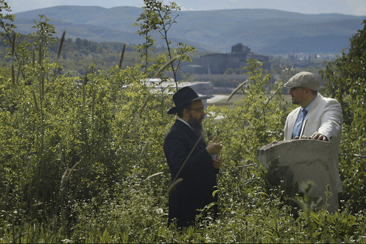A few weeks ago, the Tribeca Film Festival announced the screening of a documentary examining the link between autism and vaccination, Vaxxed: From Cover-Up to Catastrophe. After controversy erupted, the festival first stood by the entry, then removed it. Other offerings won’t generate this kind of uproar. This year’s festival offers a wide range of documentaries that are timely and confidently made, with The Happy Film an example of finesse. One caveat: Some of the films aim to take on big, issue-burdened personalities but feel reluctant to fully engage or confront their subjects, opting instead for a respectful distance.
After Spring
Wheels roll, hands arrange goods, and people fan out on the move in the opening scenes in this portrait of Jordan’s Za’atari camp, with 80,000 inhabitants, the largest in the world. The nonstop bustle feels painfully ironic, as the Syrian crisis now enters its sixth year and most people in the camp find themselves trapped there with no forward motion in sight. Executive produced by Jon Stewart, the film concentrates on two refugee families (one almost content, the other one nowhere near) and on the camp’s administrators: old United Nations hand Kilian Kleinschmidt, who runs the place with level-headed gusto; Maram, a young woman performing the role of social worker a lot longer than she anticipated; and tae kwon do instructor Charles Lee, helping kids at loose ends learn discipline and let off steam through martial arts.
Camp bigwigs are more open and revealing about themselves than camp dwellers, so we learn more about the keepers than the kept. Filmmakers may rely excessively on tae kwon do sequences, and though training is positive and photogenic, it seems unlikely to solve any real problems in the long term. Nevertheless, the film communicates the enormous scope of the Syrian disaster and the miserable dislocation it has caused. Home videos of happy lives left behind communicate a keen sense of loss in a way interviews cannot. Glimmers of hope emerge against high odds in moments such as the birth of a baby or from the plans to return home “after spring”—this hopeful phrase giving rise to the film’s title.
The Happy Film
Brilliant, celebrated graphic designer Stefan Sagmeister has conquered the world of design. Inspiration and money are not a problem. So why can’t he be happier? With the help of psychologist Jonathan Haidt, Sagmeister tries first meditation, then therapy, and finally medication to achieve happiness. The eccentric Sagmeister shows wonder, vulnerability, and a caustic side as he reflects on his past, falls in and out of love three times, and tries to force his way to happiness through thoughtful introspection and silly gimmicks. His setback-plagued journey is an extended groove on the whole concept of happiness.
However, a tragedy in the narrative seems underdeveloped and the reaction to it not completely sincere. Preoccupations of a pampered creative-class milieu come off elitist and precious, and Sagmeister’s faux-modest self-absorption can grate. No one ever really confronts the artist, who could use a challenge on terms other than his own. But there is no denying the artist’s appeal. His playful, ingenious designs infuse the movie with buoyant delight. He is a dashing individual with a cerebral, unpredictable, and often very funny take on the world. Design lovers and fans of Euro-style whimsy will gobble up this film like a light pastry dusted with powdered sugar.
Keep Quiet
“What makes the Holocaust so special?” A supposedly reformed right-wing neo-Nazi leader can’t resist trolling an elderly camp survivor on the train to Auschwitz with this insulting question. That’s just one of the queasy scenes playing out in a dark, chilly documentary about buried secrets and warped identities. Since his teens, Csanad Szegedi sought leadership in the Jobbik, Hungary’s far-right anti-Semitic party. When a disturbed colleague rats him out as Jewish, it provokes a reckoning with his deep-in-denial family and an alliance with a waggish rabbi who wants to guide him to reconciliation with his heritage. Szegedi now aims for a high profile with apology tours to the Jews he once slandered and harassed. On the stage and in this film, he hungers for the spotlight, all the while offering a still oddly unrevealing face to the world.
Lacking in self-awareness, the impassive, closed-off Szegedi makes an unappealing companion over the long haul. His motives are unreadable as well as the filmmakers’ as they shy away from drawing conclusions about a subject whom many viewers will instinctively find dodgy. Still, his story will not fail to provoke stunned reflection on generations of Eastern European hatred and the depths humans will undertake to shut out the past. In a movie a little too in love with its own ambiguity and where people are uncomfortable talking about charged subjects, veteran journalist Anne Applebaum provides background context and strong statements about the one-time politician’s double act. Scenes where Jews confront Szegedi about his past bring a jolt of anger (or is it karma?) that feels refreshing and real.
Command and Control
What a difference the turn of a ratchet makes. Two young military men at the massive Titan II nuclear warhead arsenal in Damascus, Arkansas, learned that the hard way one September evening in 1980: a chunk of metal dislodged by the wrong tool fell 80 feet and punctured a missile, setting off alarms, releasing toxic gas, and threatening an eyeball-melting nuclear explosion. Vice President Walter Mondale and then Governor Bill Clinton happened to be at the state Democratic Party convention not 50 miles away and would have been vaporized by the blast, along with millions of people all the way up to New England. Filmmakers make the point that dangerous nuclear accidents take place far more frequently than we know. They also reveal a story that reflects very poorly on the U.S. military, which abandoned or punished heroic emergency workers and then tried to cover up the whole incident.
Voice-over narration is currently unfashionable in documentary film, but it would have provided a faster, clearer route to the story than cobbling the time line out of interviews. (It was produced with PBS’s WGBH; TV-style reenactments can look a little generic.) On the plus side, ample evidence of nuclear near-misses boggles the mind. Rock-ribbed, self-effacing characters’ calm recounting of a catastrophe evokes admiration and sympathy.



















Leave A Comment